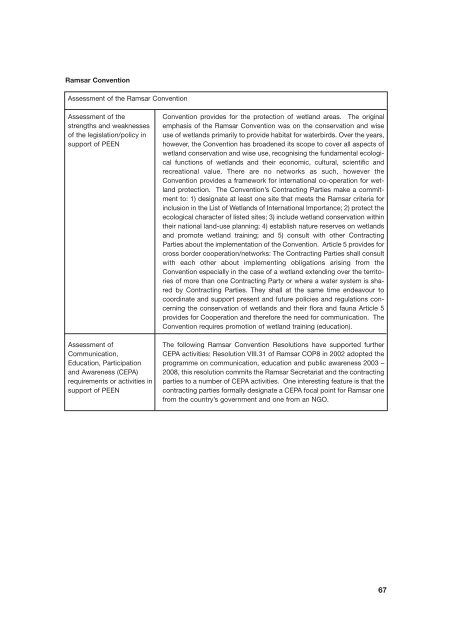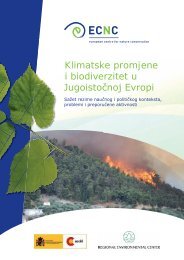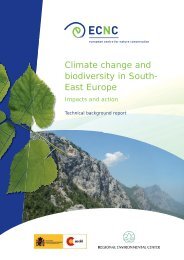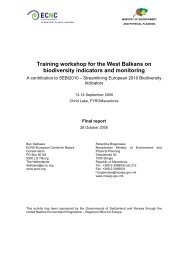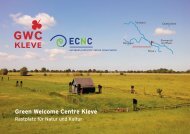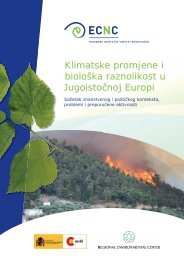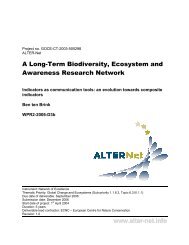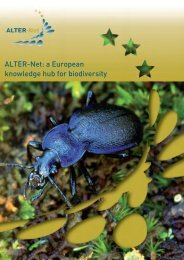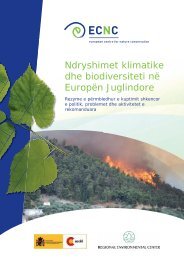Ramsar ConventionAssessment of <strong>the</strong> Ramsar ConventionAssessment of <strong>the</strong>strengths and weaknessesof <strong>the</strong> legislation/policy insupport of PEENAssessment ofCommunication,Education, Participationand Awareness (CEPA)requirements or activities insupport of PEENConvention provides for <strong>the</strong> protection of wetland areas. The originalemphasis of <strong>the</strong> Ramsar Convention was on <strong>the</strong> conservation and wiseuse of wetlands primarily to provide habitat for waterbirds. Over <strong>the</strong> years,however, <strong>the</strong> Convention has broadened its scope to cover all aspects ofwetland conservation and wise use, recognising <strong>the</strong> fundamental ecologicalfunctions of wetlands and <strong>the</strong>ir economic, cultural, scientific andrecreational value. There are no networks as such, however <strong>the</strong>Convention provides a framework for international co-operation for wetlandprotection. The Convention’s Contracting Parties make a commitmentto: 1) designate at least one site that meets <strong>the</strong> Ramsar criteria forinclusion in <strong>the</strong> List of Wetlands of International Importance; 2) protect <strong>the</strong>ecological character of listed sites; 3) include wetland conservation within<strong>the</strong>ir national land-use planning; 4) establish nature reserves on wetlandsand promote wetland training; and 5) consult with o<strong>the</strong>r ContractingParties about <strong>the</strong> implementation of <strong>the</strong> Convention. Article 5 provides forcross border cooperation/networks: The Contracting Parties shall consultwith each o<strong>the</strong>r about implementing obligations arising from <strong>the</strong>Convention especially in <strong>the</strong> case of a wetland extending over <strong>the</strong> territoriesof more than one Contracting Party or where a water system is sharedby Contracting Parties. They shall at <strong>the</strong> same time endeavour tocoordinate and support present and future policies and regulations concerning<strong>the</strong> conservation of wetlands and <strong>the</strong>ir flora and fauna Article 5provides for Cooperation and <strong>the</strong>refore <strong>the</strong> need for communication. TheConvention requires promotion of wetland training (education).The following Ramsar Convention Resolutions have supported fur<strong>the</strong>rCEPA activities: Resolution VIII.31 of Ramsar COP8 in 2002 adopted <strong>the</strong>programme on communication, education and public awareness 2003 –2008, this resolution commits <strong>the</strong> Ramsar Secretariat and <strong>the</strong> contractingparties to a number of CEPA activities. One interesting feature is that <strong>the</strong>contracting parties formally designate a CEPA focal point for Ramsar onefrom <strong>the</strong> country’s government and one from an NGO.67
World Heritage ConventionAssessment of <strong>the</strong> World Heritage ConventionAssessment of <strong>the</strong>strengths and weaknessesof <strong>the</strong> legislation/policy insupport of PEENThis Convention is related to PEEN in respect of covering natural and culturalareas of outstanding interest including buffer zones.Assessment ofCommunication,Education, Participationand Awareness (CEPA)requirements or activitiesin support of PEENArticle 5 refers to training: to foster <strong>the</strong> establishment or development ofnational or regional centres for training (education) in <strong>the</strong> protection, conservationand presentation of <strong>the</strong> cultural and natural heritage and toencourage scientific research in this field Article 27 refers to <strong>the</strong> need ofEducation: The States Parties to this Convention shall endeavour by allappropriate means, and in particular by educational and information programmes,to streng<strong>the</strong>n appreciation and respect by <strong>the</strong>ir peoples of <strong>the</strong>cultural and natural heritage. They shall undertake to keep <strong>the</strong> public broadlyinformed of <strong>the</strong> dangers threatening this heritage and of <strong>the</strong> activitiescarried on in pursuance of this ConventionConvention on Biological DiversityAssessment of <strong>the</strong> Convention on Biological DiversityAssessment of <strong>the</strong>strengths and weaknessesof <strong>the</strong> legislation/policy insupport of PEENThe CBD is not a prescriptive instrument, understandably as it addressesglobal issues whilst emphasising that measure should always be taken at<strong>the</strong> appropriate level and scale. The CBD covers cross-border internationalcooperation and contains obligations for communication and cooperationbetween countries.The CBD openly supports o<strong>the</strong>r Conventions and legislation, <strong>the</strong>reforewhilst <strong>the</strong>re is no specific mention of, or support to, PEEN, it is coveredunder this general requirement of <strong>the</strong> Convention. Support for voluntarymeasures (such as PEEN) is given via support for country-level actionplans etc. designed to support <strong>the</strong> implementation of <strong>the</strong> CBD. There isa common goal in <strong>the</strong> CBD’s and PEEN’s protection of marine areas,protected areas, protection of species)Assessment ofCommunication,Education, Participationand Awareness (CEPA)requirements or activitiesin support of PEENAt its sixth meeting, <strong>the</strong> COP reaffirmed <strong>the</strong> importance of cooperationand <strong>the</strong> need to design and implement mutually supportive activities witho<strong>the</strong>r conventions, international organizations and initiatives. In particular,<strong>the</strong> COP underlined cooperation with <strong>the</strong> following organizations onspecified issues: FAO, UNFCCC, UNCCD, <strong>the</strong> Ramsar Convention onWetlands, CMS, CITES, WTO, IPPC, and WIO.35Marine <strong>Network</strong>s: Through <strong>the</strong> Jakarta Mandate on Marine and CoastalBiodiversity (1995), <strong>the</strong> CBD addresses ecological networks: TheConvention focuses on integrated marine and coastal area management,<strong>the</strong> sustainable use of living resources, marine and coastal protectedareas, mariculture and alien species.68
- Page 1 and 2:
european centre for nature conserva
- Page 3 and 4:
Published by:This publication was m
- Page 5 and 6:
Executive SummaryIn 2003, ECNC publ
- Page 7 and 8:
●●The study has highlighted the
- Page 9 and 10:
NetherlandsEstoniaNorwayUnited King
- Page 11 and 12:
PEEN - a Europe wide ecological net
- Page 13 and 14:
Experiences at the EU level, regard
- Page 15 and 16:
there may also be huge variations i
- Page 17 and 18: on the effectiveness of implementat
- Page 19 and 20: e the working group involving natio
- Page 21 and 22: Opportunities or challenges for eco
- Page 24 and 25: As mentioned above, there are a lot
- Page 26 and 27: It was felt by some respondents tha
- Page 28 and 29: gained by the work of the NGOs, sci
- Page 30 and 31: nature conservation societies (Prov
- Page 32 and 33: ● Local level support for interna
- Page 34 and 35: istics of the Norwegian landscape,
- Page 36 and 37: policymaking, involving stakeholder
- Page 38 and 39: Some respondents thought a map was
- Page 40 and 41: semi-natural habitats. One responde
- Page 42 and 43: In Scotland, there is a lot of work
- Page 44 and 45: policymakers, researchers, scientis
- Page 46 and 47: Experience and expertise:Over the p
- Page 48 and 49: knowledge also exists regarding the
- Page 50 and 51: At an international level, this is
- Page 52 and 53: lack of integration of policies reg
- Page 54 and 55: ottom-up approach of PEEN requires
- Page 56 and 57: 5 ReferencesSandra Rientjes & Kater
- Page 58 and 59: Methodological Outline●●●●
- Page 60 and 61: CPA 1 A3Communicating PEENDESK STUD
- Page 62 and 63: IntroductionThe desk review of the
- Page 64 and 65: The following two tables, adapted f
- Page 66 and 67: Habitats DirectiveAssessment of the
- Page 70 and 71: Assessment ofCommunication,Educatio
- Page 72 and 73: and other European states, four rep
- Page 74 and 75: The Act on Sustainable Development
- Page 76 and 77: In Germany nature conservation by l
- Page 78 and 79: The management of protected areas f
- Page 80 and 81: The NvM and the NMP4 are devoted to
- Page 82 and 83: Assessment of policy and legislatio
- Page 84 and 85: A Species Action Plan (SAP) has bee
- Page 86 and 87: CPA 1 A3Communicating PEENExecutive
- Page 88 and 89: Practical experiences with developi


